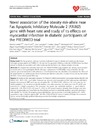Please use this identifier to cite or link to this item:
https://accedacris.ulpgc.es/jspui/handle/10553/44651
| Title: | Novel association of the obesity risk-allele near Fas Apoptotic Inhibitory Molecule 2 (FAIM2) gene with heart rate and study of its effects on myocardial infarction in diabetic participants of the PREDIMED trial | Authors: | Corella, Dolores Sorlí, Jose V. González, José I. Ortega, Carolina Fitó, Montserrat Bulló, Monica Martínez-González, Miguel A. Ros, Emilio Arós, Fernando Lapetra, José Gómez-Gracia, Enrique Serra-Majem, Lluís Ruiz-Gutierrez, Valentina Fiol, Miquel Coltell, Oscar Vinyoles, Ernest Pintó, Xavier Martí, Amelia Saiz, Carmen Ordovás, José M. Estruch, Ramón |
UNESCO Clasification: | 3206 Ciencias de la nutrición | Keywords: | Body-Mass Index Genome-Wide Association Coronary-Artery-Disease Cardiovascular-Disease Mediterranean Diet, et al |
Issue Date: | 2014 | Project: | Preparacion de la Guia Para la Reduccion de los Desperdicios Alimentarios-Documento Ciber Obn, Fin y Nsf Red Alimentación Saludable en la Prevención Primaria de Enfermedades Crónicas: la Red Predimed. (Retics 2006) |
Journal: | Cardiovascular Diabetology | Abstract: | Background: The Fas apoptotic pathway has been implicated in type 2 diabetes and cardiovascular disease. Although a polymorphism (rs7138803; G > A) near the Fas apoptotic inhibitory molecule 2 (FAIM2) locus has been related to obesity, its association with other cardiovascular risk factors and disease remains uncertain.Methods: We analyzed the association between the FAIM2-rs7138803 polymorphism and obesity, blood pressure and heart rate in 7,161 participants (48.3% with type 2 diabetes) in the PREDIMED study at baseline. We also explored gene-diet interactions with adherence to the Mediterranean diet (MedDiet) and examined the effects of the polymorphism on cardiovascular disease incidence per diabetes status after a median 4.8-year dietary intervention (MedDiet versus control group) follow-up.Results: We replicated the association between the FAIM2-rs7138803 polymorphism and greater obesity risk (OR: 1.08; 95% CI: 1.01-1.16; P = 0.011; per-A allele). Moreover, we detected novel associations of this polymorphism with higher diastolic blood pressure (DBP) and heart rate at baseline (B = 1.07; 95% CI: 0.97-1.28 bmp in AA vs G-carriers for the whole population), that remained statistically significant even after adjustment for body mass index (P = 0.012) and correction for multiple comparisons. This association was greater and statistically significant in type-2 diabetic subjects (B = 1.44: 95% CI: 0.23-2.56 bmp; P = 0.010 for AA versus G-carriers). Likewise, these findings were also observed longitudinally over 5-year follow-up. Nevertheless, we found no statistically significant gene-diet interactions with MedDiet for this trait. On analyzing myocardial infarction risk, we detected a nominally significant (P = 0.041) association in type-2 diabetic subjects (HR: 1.86; 95% CI: 1.03-3.37 for AA versus G-carriers), although this association did not remain statistically significant following correction for multiple comparisons.Conclusions: We confirmed the FAIM2-rs7138803 relationship with obesity and identified novel and consistent associations with heart rate in particular in type 2 diabetic subjects. Furthermore, our results suggest a possible association of this polymorphism with higher myocardial infarction risk in type-2 diabetic subjects, although this result needs to be replicated as it could represent a false positive. | URI: | https://accedacris.ulpgc.es/handle/10553/44651 | ISSN: | 1475-2840 | DOI: | 10.1186/1475-2840-13-5 | Source: | Cardiovascular Diabetology [EISSN 1475-2840], v. 13, article number 5, (Enero 2014) |
| Appears in Collections: | Artículos |
SCOPUSTM
Citations
12
checked on Jun 8, 2025
WEB OF SCIENCETM
Citations
11
checked on Jun 8, 2025
Page view(s)
78
checked on Mar 9, 2024
Download(s)
69
checked on Mar 9, 2024
Google ScholarTM
Check
Altmetric
Share
Export metadata
Items in accedaCRIS are protected by copyright, with all rights reserved, unless otherwise indicated.
